Operational Management and Leadership Roles within Corus Steel Company
VerifiedAdded on 2021/02/21
|15
|4686
|18
Report
AI Summary
This report provides an in-depth analysis of leadership and management practices at Corus Steel, a steel producer and part of the Tata Steel Group. The report begins by differentiating between the roles of leaders and managers, highlighting their characteristics and responsibilities. It then explores the importance of decision-making processes, particularly in the context of a global company like Corus, and examines how leadership can facilitate organizational changes, such as the adoption of new technologies. Furthermore, the report delves into various operational management models, including situational, system, and contingency leadership, and assesses their strengths and weaknesses. The analysis covers how these leadership approaches impact the business environment and contribute to the achievement of organizational goals. The report emphasizes the importance of adapting leadership styles to specific situations and making informed decisions to ensure Corus's success.
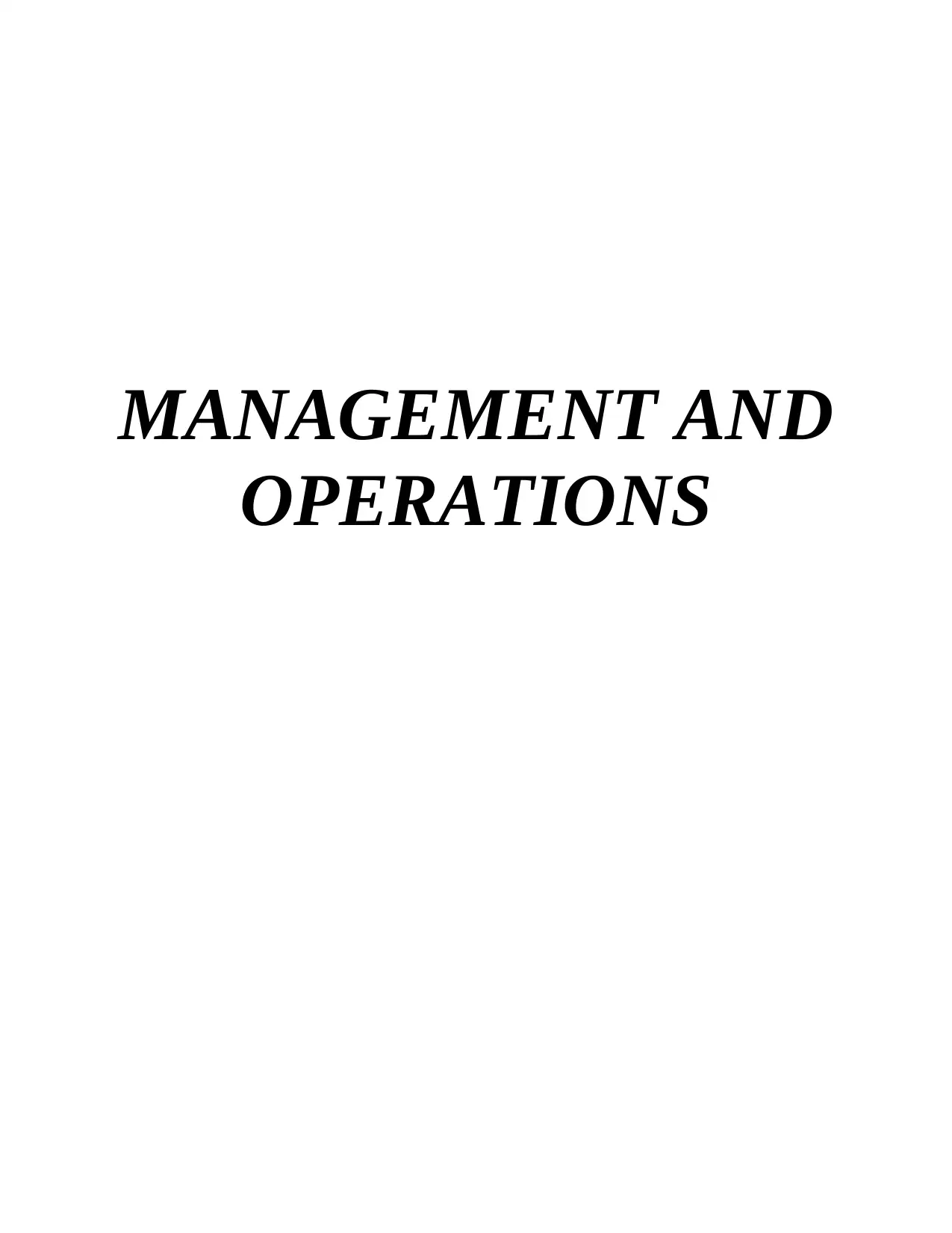
MANAGEMENT AND
OPERATIONS
OPERATIONS
Paraphrase This Document
Need a fresh take? Get an instant paraphrase of this document with our AI Paraphraser
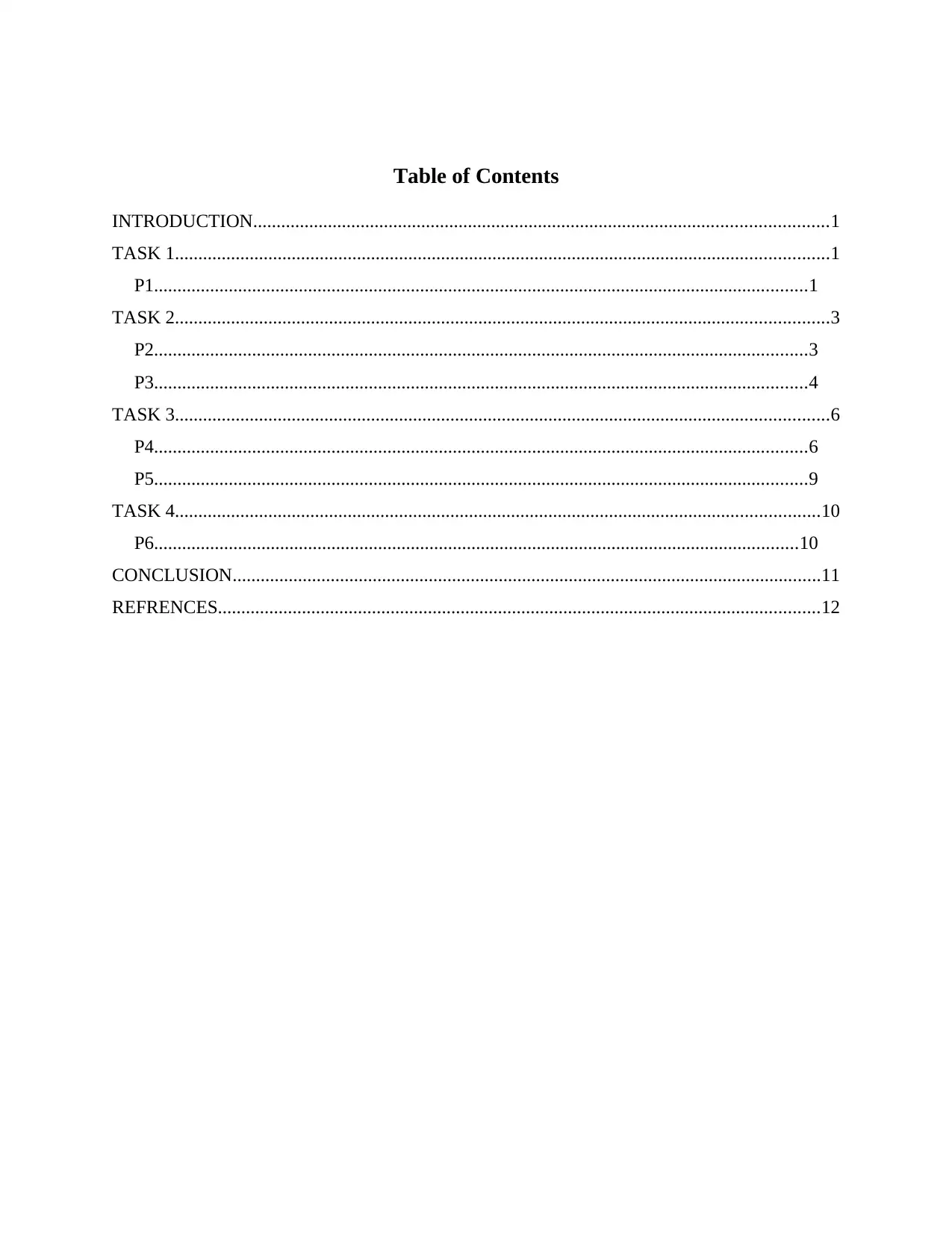
Table of Contents
INTRODUCTION...........................................................................................................................1
TASK 1............................................................................................................................................1
P1............................................................................................................................................1
TASK 2............................................................................................................................................3
P2............................................................................................................................................3
P3............................................................................................................................................4
TASK 3............................................................................................................................................6
P4............................................................................................................................................6
P5............................................................................................................................................9
TASK 4..........................................................................................................................................10
P6..........................................................................................................................................10
CONCLUSION..............................................................................................................................11
REFRENCES.................................................................................................................................12
INTRODUCTION...........................................................................................................................1
TASK 1............................................................................................................................................1
P1............................................................................................................................................1
TASK 2............................................................................................................................................3
P2............................................................................................................................................3
P3............................................................................................................................................4
TASK 3............................................................................................................................................6
P4............................................................................................................................................6
P5............................................................................................................................................9
TASK 4..........................................................................................................................................10
P6..........................................................................................................................................10
CONCLUSION..............................................................................................................................11
REFRENCES.................................................................................................................................12
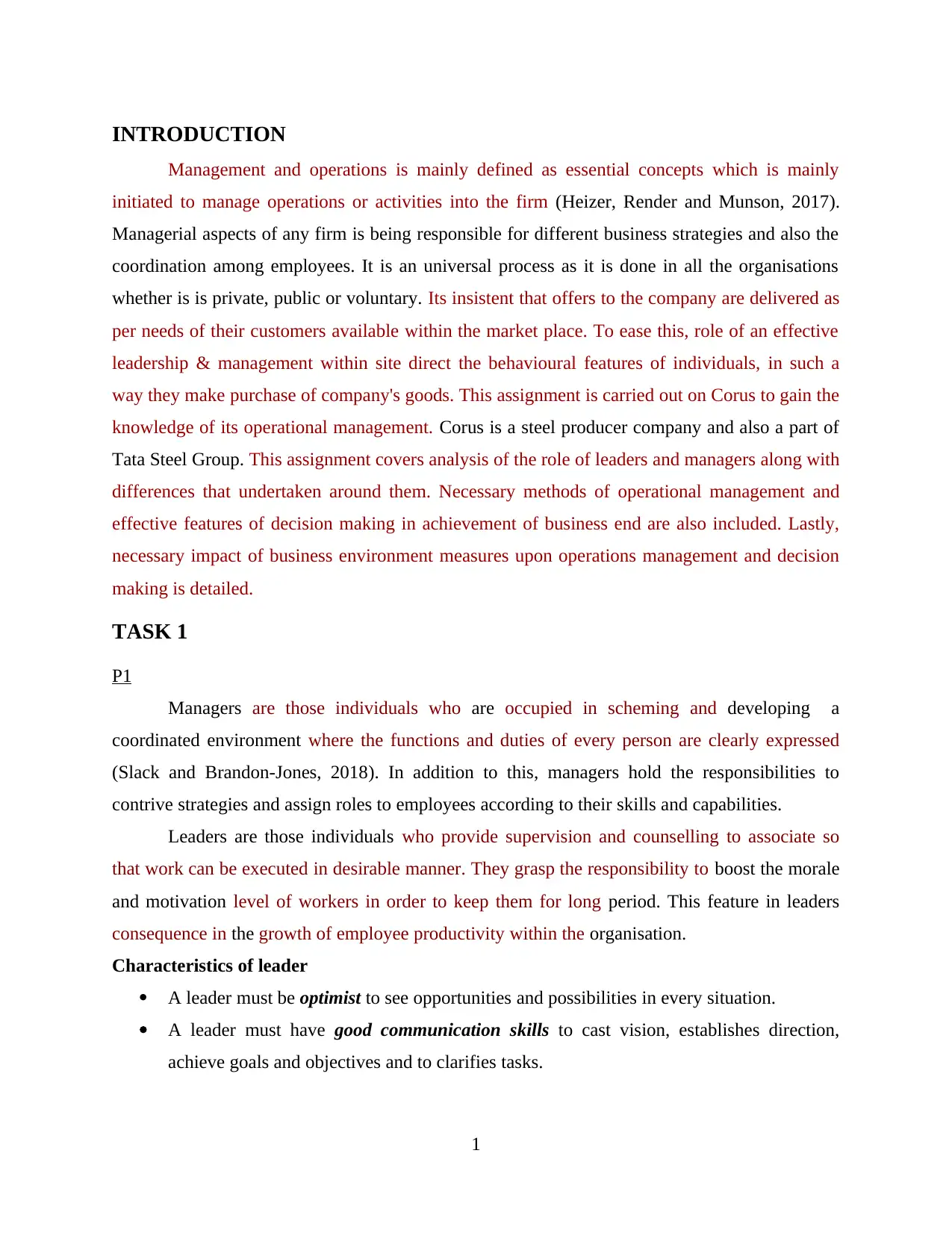
INTRODUCTION
Management and operations is mainly defined as essential concepts which is mainly
initiated to manage operations or activities into the firm (Heizer, Render and Munson, 2017).
Managerial aspects of any firm is being responsible for different business strategies and also the
coordination among employees. It is an universal process as it is done in all the organisations
whether is is private, public or voluntary. Its insistent that offers to the company are delivered as
per needs of their customers available within the market place. To ease this, role of an effective
leadership & management within site direct the behavioural features of individuals, in such a
way they make purchase of company's goods. This assignment is carried out on Corus to gain the
knowledge of its operational management. Corus is a steel producer company and also a part of
Tata Steel Group. This assignment covers analysis of the role of leaders and managers along with
differences that undertaken around them. Necessary methods of operational management and
effective features of decision making in achievement of business end are also included. Lastly,
necessary impact of business environment measures upon operations management and decision
making is detailed.
TASK 1
P1
Managers are those individuals who are occupied in scheming and developing a
coordinated environment where the functions and duties of every person are clearly expressed
(Slack and Brandon-Jones, 2018). In addition to this, managers hold the responsibilities to
contrive strategies and assign roles to employees according to their skills and capabilities.
Leaders are those individuals who provide supervision and counselling to associate so
that work can be executed in desirable manner. They grasp the responsibility to boost the morale
and motivation level of workers in order to keep them for long period. This feature in leaders
consequence in the growth of employee productivity within the organisation.
Characteristics of leader
A leader must be optimist to see opportunities and possibilities in every situation.
A leader must have good communication skills to cast vision, establishes direction,
achieve goals and objectives and to clarifies tasks.
1
Management and operations is mainly defined as essential concepts which is mainly
initiated to manage operations or activities into the firm (Heizer, Render and Munson, 2017).
Managerial aspects of any firm is being responsible for different business strategies and also the
coordination among employees. It is an universal process as it is done in all the organisations
whether is is private, public or voluntary. Its insistent that offers to the company are delivered as
per needs of their customers available within the market place. To ease this, role of an effective
leadership & management within site direct the behavioural features of individuals, in such a
way they make purchase of company's goods. This assignment is carried out on Corus to gain the
knowledge of its operational management. Corus is a steel producer company and also a part of
Tata Steel Group. This assignment covers analysis of the role of leaders and managers along with
differences that undertaken around them. Necessary methods of operational management and
effective features of decision making in achievement of business end are also included. Lastly,
necessary impact of business environment measures upon operations management and decision
making is detailed.
TASK 1
P1
Managers are those individuals who are occupied in scheming and developing a
coordinated environment where the functions and duties of every person are clearly expressed
(Slack and Brandon-Jones, 2018). In addition to this, managers hold the responsibilities to
contrive strategies and assign roles to employees according to their skills and capabilities.
Leaders are those individuals who provide supervision and counselling to associate so
that work can be executed in desirable manner. They grasp the responsibility to boost the morale
and motivation level of workers in order to keep them for long period. This feature in leaders
consequence in the growth of employee productivity within the organisation.
Characteristics of leader
A leader must be optimist to see opportunities and possibilities in every situation.
A leader must have good communication skills to cast vision, establishes direction,
achieve goals and objectives and to clarifies tasks.
1
⊘ This is a preview!⊘
Do you want full access?
Subscribe today to unlock all pages.

Trusted by 1+ million students worldwide
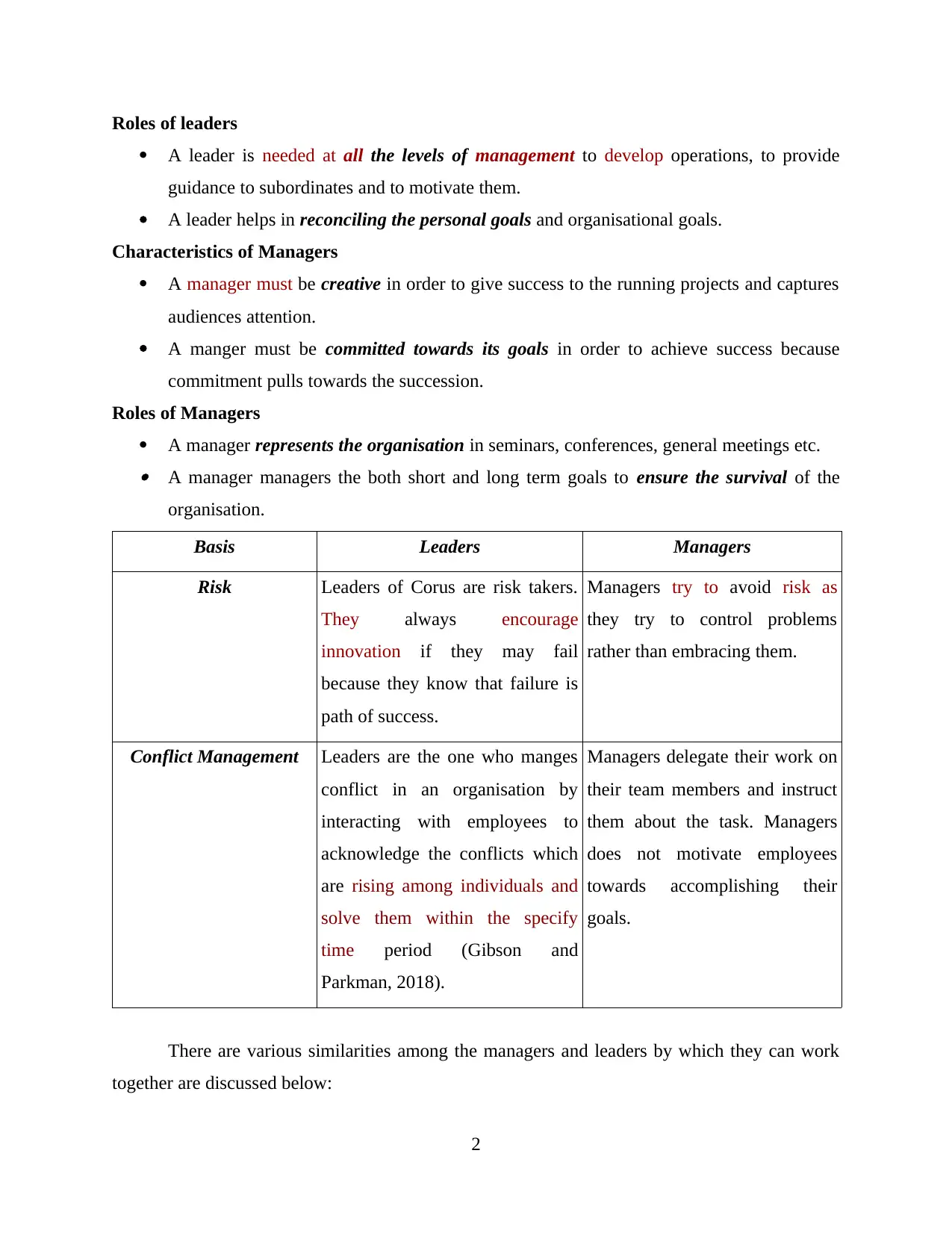
Roles of leaders
A leader is needed at all the levels of management to develop operations, to provide
guidance to subordinates and to motivate them.
A leader helps in reconciling the personal goals and organisational goals.
Characteristics of Managers
A manager must be creative in order to give success to the running projects and captures
audiences attention.
A manger must be committed towards its goals in order to achieve success because
commitment pulls towards the succession.
Roles of Managers
A manager represents the organisation in seminars, conferences, general meetings etc. A manager managers the both short and long term goals to ensure the survival of the
organisation.
Basis Leaders Managers
Risk Leaders of Corus are risk takers.
They always encourage
innovation if they may fail
because they know that failure is
path of success.
Managers try to avoid risk as
they try to control problems
rather than embracing them.
Conflict Management Leaders are the one who manges
conflict in an organisation by
interacting with employees to
acknowledge the conflicts which
are rising among individuals and
solve them within the specify
time period (Gibson and
Parkman, 2018).
Managers delegate their work on
their team members and instruct
them about the task. Managers
does not motivate employees
towards accomplishing their
goals.
There are various similarities among the managers and leaders by which they can work
together are discussed below:
2
A leader is needed at all the levels of management to develop operations, to provide
guidance to subordinates and to motivate them.
A leader helps in reconciling the personal goals and organisational goals.
Characteristics of Managers
A manager must be creative in order to give success to the running projects and captures
audiences attention.
A manger must be committed towards its goals in order to achieve success because
commitment pulls towards the succession.
Roles of Managers
A manager represents the organisation in seminars, conferences, general meetings etc. A manager managers the both short and long term goals to ensure the survival of the
organisation.
Basis Leaders Managers
Risk Leaders of Corus are risk takers.
They always encourage
innovation if they may fail
because they know that failure is
path of success.
Managers try to avoid risk as
they try to control problems
rather than embracing them.
Conflict Management Leaders are the one who manges
conflict in an organisation by
interacting with employees to
acknowledge the conflicts which
are rising among individuals and
solve them within the specify
time period (Gibson and
Parkman, 2018).
Managers delegate their work on
their team members and instruct
them about the task. Managers
does not motivate employees
towards accomplishing their
goals.
There are various similarities among the managers and leaders by which they can work
together are discussed below:
2
Paraphrase This Document
Need a fresh take? Get an instant paraphrase of this document with our AI Paraphraser
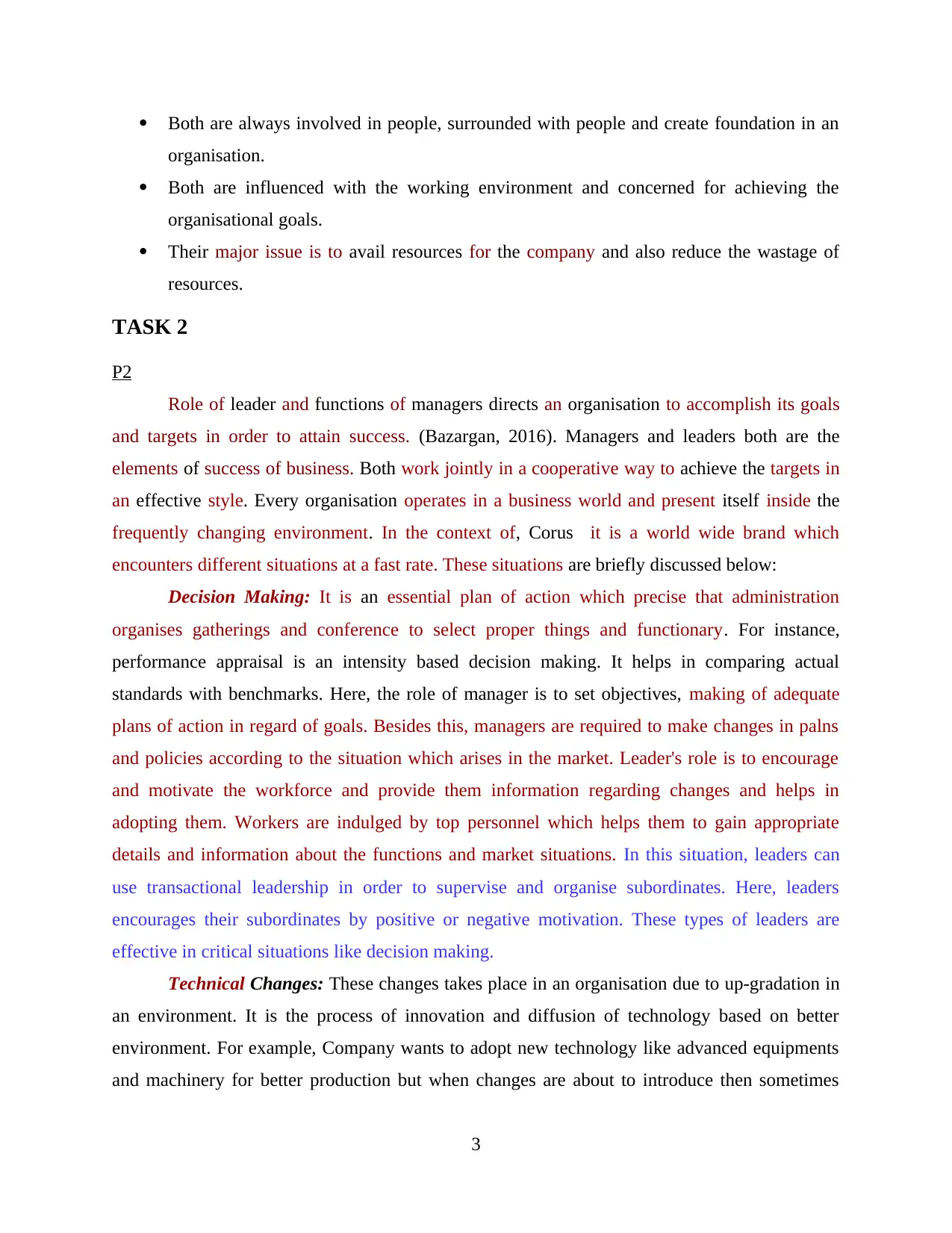
Both are always involved in people, surrounded with people and create foundation in an
organisation.
Both are influenced with the working environment and concerned for achieving the
organisational goals.
Their major issue is to avail resources for the company and also reduce the wastage of
resources.
TASK 2
P2
Role of leader and functions of managers directs an organisation to accomplish its goals
and targets in order to attain success. (Bazargan, 2016). Managers and leaders both are the
elements of success of business. Both work jointly in a cooperative way to achieve the targets in
an effective style. Every organisation operates in a business world and present itself inside the
frequently changing environment. In the context of, Corus it is a world wide brand which
encounters different situations at a fast rate. These situations are briefly discussed below:
Decision Making: It is an essential plan of action which precise that administration
organises gatherings and conference to select proper things and functionary. For instance,
performance appraisal is an intensity based decision making. It helps in comparing actual
standards with benchmarks. Here, the role of manager is to set objectives, making of adequate
plans of action in regard of goals. Besides this, managers are required to make changes in palns
and policies according to the situation which arises in the market. Leader's role is to encourage
and motivate the workforce and provide them information regarding changes and helps in
adopting them. Workers are indulged by top personnel which helps them to gain appropriate
details and information about the functions and market situations. In this situation, leaders can
use transactional leadership in order to supervise and organise subordinates. Here, leaders
encourages their subordinates by positive or negative motivation. These types of leaders are
effective in critical situations like decision making.
Technical Changes: These changes takes place in an organisation due to up-gradation in
an environment. It is the process of innovation and diffusion of technology based on better
environment. For example, Company wants to adopt new technology like advanced equipments
and machinery for better production but when changes are about to introduce then sometimes
3
organisation.
Both are influenced with the working environment and concerned for achieving the
organisational goals.
Their major issue is to avail resources for the company and also reduce the wastage of
resources.
TASK 2
P2
Role of leader and functions of managers directs an organisation to accomplish its goals
and targets in order to attain success. (Bazargan, 2016). Managers and leaders both are the
elements of success of business. Both work jointly in a cooperative way to achieve the targets in
an effective style. Every organisation operates in a business world and present itself inside the
frequently changing environment. In the context of, Corus it is a world wide brand which
encounters different situations at a fast rate. These situations are briefly discussed below:
Decision Making: It is an essential plan of action which precise that administration
organises gatherings and conference to select proper things and functionary. For instance,
performance appraisal is an intensity based decision making. It helps in comparing actual
standards with benchmarks. Here, the role of manager is to set objectives, making of adequate
plans of action in regard of goals. Besides this, managers are required to make changes in palns
and policies according to the situation which arises in the market. Leader's role is to encourage
and motivate the workforce and provide them information regarding changes and helps in
adopting them. Workers are indulged by top personnel which helps them to gain appropriate
details and information about the functions and market situations. In this situation, leaders can
use transactional leadership in order to supervise and organise subordinates. Here, leaders
encourages their subordinates by positive or negative motivation. These types of leaders are
effective in critical situations like decision making.
Technical Changes: These changes takes place in an organisation due to up-gradation in
an environment. It is the process of innovation and diffusion of technology based on better
environment. For example, Company wants to adopt new technology like advanced equipments
and machinery for better production but when changes are about to introduce then sometimes
3
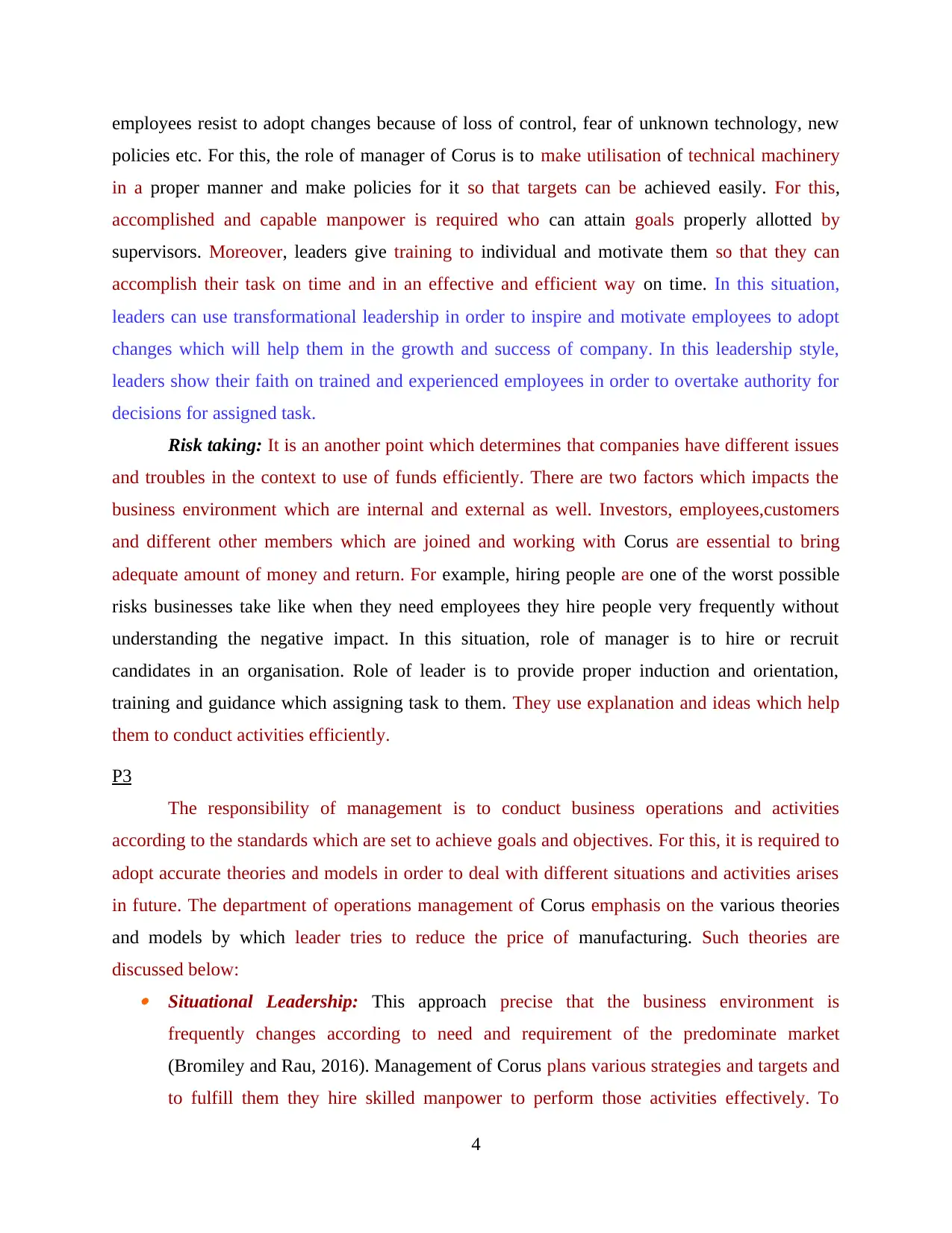
employees resist to adopt changes because of loss of control, fear of unknown technology, new
policies etc. For this, the role of manager of Corus is to make utilisation of technical machinery
in a proper manner and make policies for it so that targets can be achieved easily. For this,
accomplished and capable manpower is required who can attain goals properly allotted by
supervisors. Moreover, leaders give training to individual and motivate them so that they can
accomplish their task on time and in an effective and efficient way on time. In this situation,
leaders can use transformational leadership in order to inspire and motivate employees to adopt
changes which will help them in the growth and success of company. In this leadership style,
leaders show their faith on trained and experienced employees in order to overtake authority for
decisions for assigned task.
Risk taking: It is an another point which determines that companies have different issues
and troubles in the context to use of funds efficiently. There are two factors which impacts the
business environment which are internal and external as well. Investors, employees,customers
and different other members which are joined and working with Corus are essential to bring
adequate amount of money and return. For example, hiring people are one of the worst possible
risks businesses take like when they need employees they hire people very frequently without
understanding the negative impact. In this situation, role of manager is to hire or recruit
candidates in an organisation. Role of leader is to provide proper induction and orientation,
training and guidance which assigning task to them. They use explanation and ideas which help
them to conduct activities efficiently.
P3
The responsibility of management is to conduct business operations and activities
according to the standards which are set to achieve goals and objectives. For this, it is required to
adopt accurate theories and models in order to deal with different situations and activities arises
in future. The department of operations management of Corus emphasis on the various theories
and models by which leader tries to reduce the price of manufacturing. Such theories are
discussed below: Situational Leadership: This approach precise that the business environment is
frequently changes according to need and requirement of the predominate market
(Bromiley and Rau, 2016). Management of Corus plans various strategies and targets and
to fulfill them they hire skilled manpower to perform those activities effectively. To
4
policies etc. For this, the role of manager of Corus is to make utilisation of technical machinery
in a proper manner and make policies for it so that targets can be achieved easily. For this,
accomplished and capable manpower is required who can attain goals properly allotted by
supervisors. Moreover, leaders give training to individual and motivate them so that they can
accomplish their task on time and in an effective and efficient way on time. In this situation,
leaders can use transformational leadership in order to inspire and motivate employees to adopt
changes which will help them in the growth and success of company. In this leadership style,
leaders show their faith on trained and experienced employees in order to overtake authority for
decisions for assigned task.
Risk taking: It is an another point which determines that companies have different issues
and troubles in the context to use of funds efficiently. There are two factors which impacts the
business environment which are internal and external as well. Investors, employees,customers
and different other members which are joined and working with Corus are essential to bring
adequate amount of money and return. For example, hiring people are one of the worst possible
risks businesses take like when they need employees they hire people very frequently without
understanding the negative impact. In this situation, role of manager is to hire or recruit
candidates in an organisation. Role of leader is to provide proper induction and orientation,
training and guidance which assigning task to them. They use explanation and ideas which help
them to conduct activities efficiently.
P3
The responsibility of management is to conduct business operations and activities
according to the standards which are set to achieve goals and objectives. For this, it is required to
adopt accurate theories and models in order to deal with different situations and activities arises
in future. The department of operations management of Corus emphasis on the various theories
and models by which leader tries to reduce the price of manufacturing. Such theories are
discussed below: Situational Leadership: This approach precise that the business environment is
frequently changes according to need and requirement of the predominate market
(Bromiley and Rau, 2016). Management of Corus plans various strategies and targets and
to fulfill them they hire skilled manpower to perform those activities effectively. To
4
⊘ This is a preview!⊘
Do you want full access?
Subscribe today to unlock all pages.

Trusted by 1+ million students worldwide
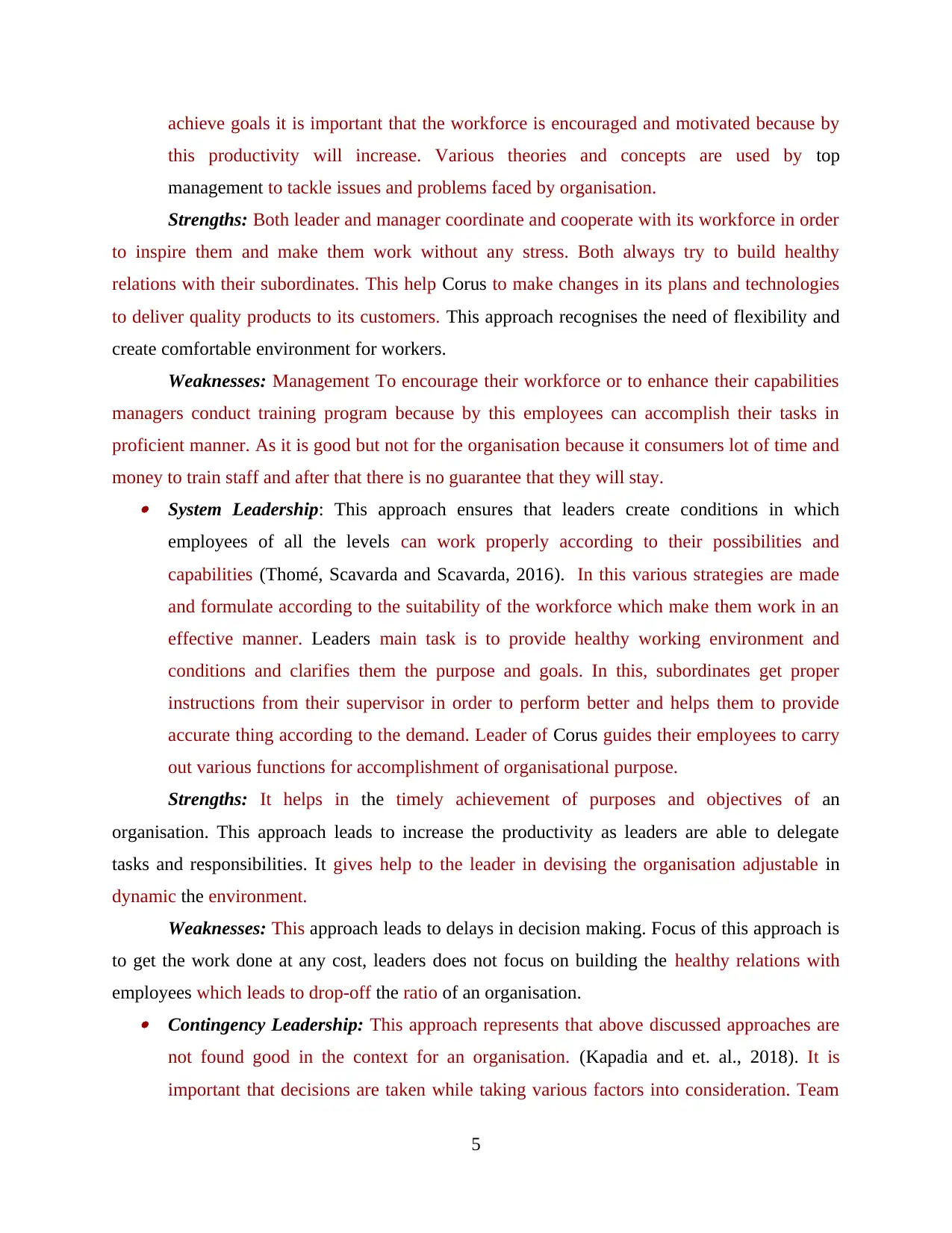
achieve goals it is important that the workforce is encouraged and motivated because by
this productivity will increase. Various theories and concepts are used by top
management to tackle issues and problems faced by organisation.
Strengths: Both leader and manager coordinate and cooperate with its workforce in order
to inspire them and make them work without any stress. Both always try to build healthy
relations with their subordinates. This help Corus to make changes in its plans and technologies
to deliver quality products to its customers. This approach recognises the need of flexibility and
create comfortable environment for workers.
Weaknesses: Management To encourage their workforce or to enhance their capabilities
managers conduct training program because by this employees can accomplish their tasks in
proficient manner. As it is good but not for the organisation because it consumers lot of time and
money to train staff and after that there is no guarantee that they will stay. System Leadership: This approach ensures that leaders create conditions in which
employees of all the levels can work properly according to their possibilities and
capabilities (Thomé, Scavarda and Scavarda, 2016). In this various strategies are made
and formulate according to the suitability of the workforce which make them work in an
effective manner. Leaders main task is to provide healthy working environment and
conditions and clarifies them the purpose and goals. In this, subordinates get proper
instructions from their supervisor in order to perform better and helps them to provide
accurate thing according to the demand. Leader of Corus guides their employees to carry
out various functions for accomplishment of organisational purpose.
Strengths: It helps in the timely achievement of purposes and objectives of an
organisation. This approach leads to increase the productivity as leaders are able to delegate
tasks and responsibilities. It gives help to the leader in devising the organisation adjustable in
dynamic the environment.
Weaknesses: This approach leads to delays in decision making. Focus of this approach is
to get the work done at any cost, leaders does not focus on building the healthy relations with
employees which leads to drop-off the ratio of an organisation. Contingency Leadership: This approach represents that above discussed approaches are
not found good in the context for an organisation. (Kapadia and et. al., 2018). It is
important that decisions are taken while taking various factors into consideration. Team
5
this productivity will increase. Various theories and concepts are used by top
management to tackle issues and problems faced by organisation.
Strengths: Both leader and manager coordinate and cooperate with its workforce in order
to inspire them and make them work without any stress. Both always try to build healthy
relations with their subordinates. This help Corus to make changes in its plans and technologies
to deliver quality products to its customers. This approach recognises the need of flexibility and
create comfortable environment for workers.
Weaknesses: Management To encourage their workforce or to enhance their capabilities
managers conduct training program because by this employees can accomplish their tasks in
proficient manner. As it is good but not for the organisation because it consumers lot of time and
money to train staff and after that there is no guarantee that they will stay. System Leadership: This approach ensures that leaders create conditions in which
employees of all the levels can work properly according to their possibilities and
capabilities (Thomé, Scavarda and Scavarda, 2016). In this various strategies are made
and formulate according to the suitability of the workforce which make them work in an
effective manner. Leaders main task is to provide healthy working environment and
conditions and clarifies them the purpose and goals. In this, subordinates get proper
instructions from their supervisor in order to perform better and helps them to provide
accurate thing according to the demand. Leader of Corus guides their employees to carry
out various functions for accomplishment of organisational purpose.
Strengths: It helps in the timely achievement of purposes and objectives of an
organisation. This approach leads to increase the productivity as leaders are able to delegate
tasks and responsibilities. It gives help to the leader in devising the organisation adjustable in
dynamic the environment.
Weaknesses: This approach leads to delays in decision making. Focus of this approach is
to get the work done at any cost, leaders does not focus on building the healthy relations with
employees which leads to drop-off the ratio of an organisation. Contingency Leadership: This approach represents that above discussed approaches are
not found good in the context for an organisation. (Kapadia and et. al., 2018). It is
important that decisions are taken while taking various factors into consideration. Team
5
Paraphrase This Document
Need a fresh take? Get an instant paraphrase of this document with our AI Paraphraser
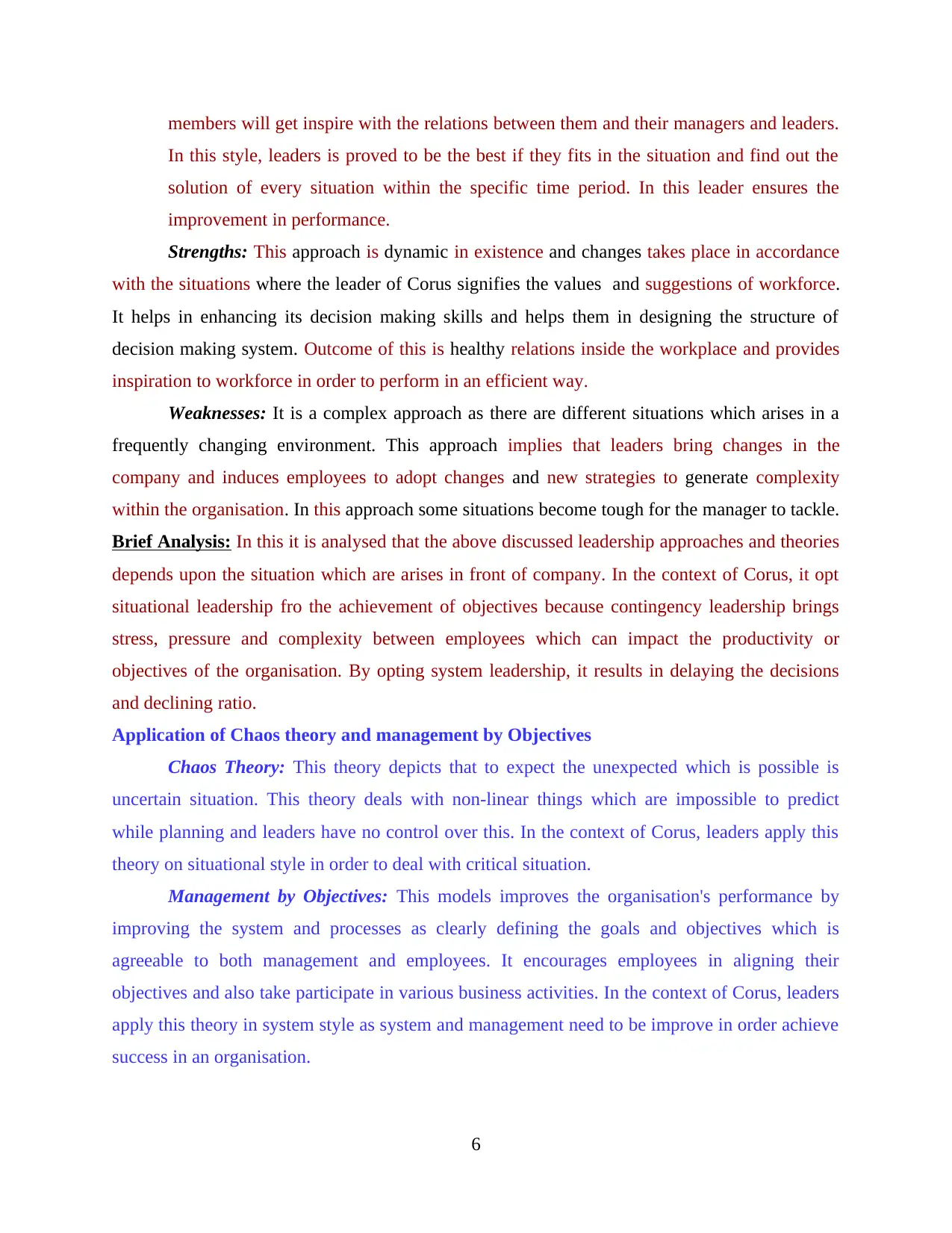
members will get inspire with the relations between them and their managers and leaders.
In this style, leaders is proved to be the best if they fits in the situation and find out the
solution of every situation within the specific time period. In this leader ensures the
improvement in performance.
Strengths: This approach is dynamic in existence and changes takes place in accordance
with the situations where the leader of Corus signifies the values and suggestions of workforce.
It helps in enhancing its decision making skills and helps them in designing the structure of
decision making system. Outcome of this is healthy relations inside the workplace and provides
inspiration to workforce in order to perform in an efficient way.
Weaknesses: It is a complex approach as there are different situations which arises in a
frequently changing environment. This approach implies that leaders bring changes in the
company and induces employees to adopt changes and new strategies to generate complexity
within the organisation. In this approach some situations become tough for the manager to tackle.
Brief Analysis: In this it is analysed that the above discussed leadership approaches and theories
depends upon the situation which are arises in front of company. In the context of Corus, it opt
situational leadership fro the achievement of objectives because contingency leadership brings
stress, pressure and complexity between employees which can impact the productivity or
objectives of the organisation. By opting system leadership, it results in delaying the decisions
and declining ratio.
Application of Chaos theory and management by Objectives
Chaos Theory: This theory depicts that to expect the unexpected which is possible is
uncertain situation. This theory deals with non-linear things which are impossible to predict
while planning and leaders have no control over this. In the context of Corus, leaders apply this
theory on situational style in order to deal with critical situation.
Management by Objectives: This models improves the organisation's performance by
improving the system and processes as clearly defining the goals and objectives which is
agreeable to both management and employees. It encourages employees in aligning their
objectives and also take participate in various business activities. In the context of Corus, leaders
apply this theory in system style as system and management need to be improve in order achieve
success in an organisation.
6
In this style, leaders is proved to be the best if they fits in the situation and find out the
solution of every situation within the specific time period. In this leader ensures the
improvement in performance.
Strengths: This approach is dynamic in existence and changes takes place in accordance
with the situations where the leader of Corus signifies the values and suggestions of workforce.
It helps in enhancing its decision making skills and helps them in designing the structure of
decision making system. Outcome of this is healthy relations inside the workplace and provides
inspiration to workforce in order to perform in an efficient way.
Weaknesses: It is a complex approach as there are different situations which arises in a
frequently changing environment. This approach implies that leaders bring changes in the
company and induces employees to adopt changes and new strategies to generate complexity
within the organisation. In this approach some situations become tough for the manager to tackle.
Brief Analysis: In this it is analysed that the above discussed leadership approaches and theories
depends upon the situation which are arises in front of company. In the context of Corus, it opt
situational leadership fro the achievement of objectives because contingency leadership brings
stress, pressure and complexity between employees which can impact the productivity or
objectives of the organisation. By opting system leadership, it results in delaying the decisions
and declining ratio.
Application of Chaos theory and management by Objectives
Chaos Theory: This theory depicts that to expect the unexpected which is possible is
uncertain situation. This theory deals with non-linear things which are impossible to predict
while planning and leaders have no control over this. In the context of Corus, leaders apply this
theory on situational style in order to deal with critical situation.
Management by Objectives: This models improves the organisation's performance by
improving the system and processes as clearly defining the goals and objectives which is
agreeable to both management and employees. It encourages employees in aligning their
objectives and also take participate in various business activities. In the context of Corus, leaders
apply this theory in system style as system and management need to be improve in order achieve
success in an organisation.
6
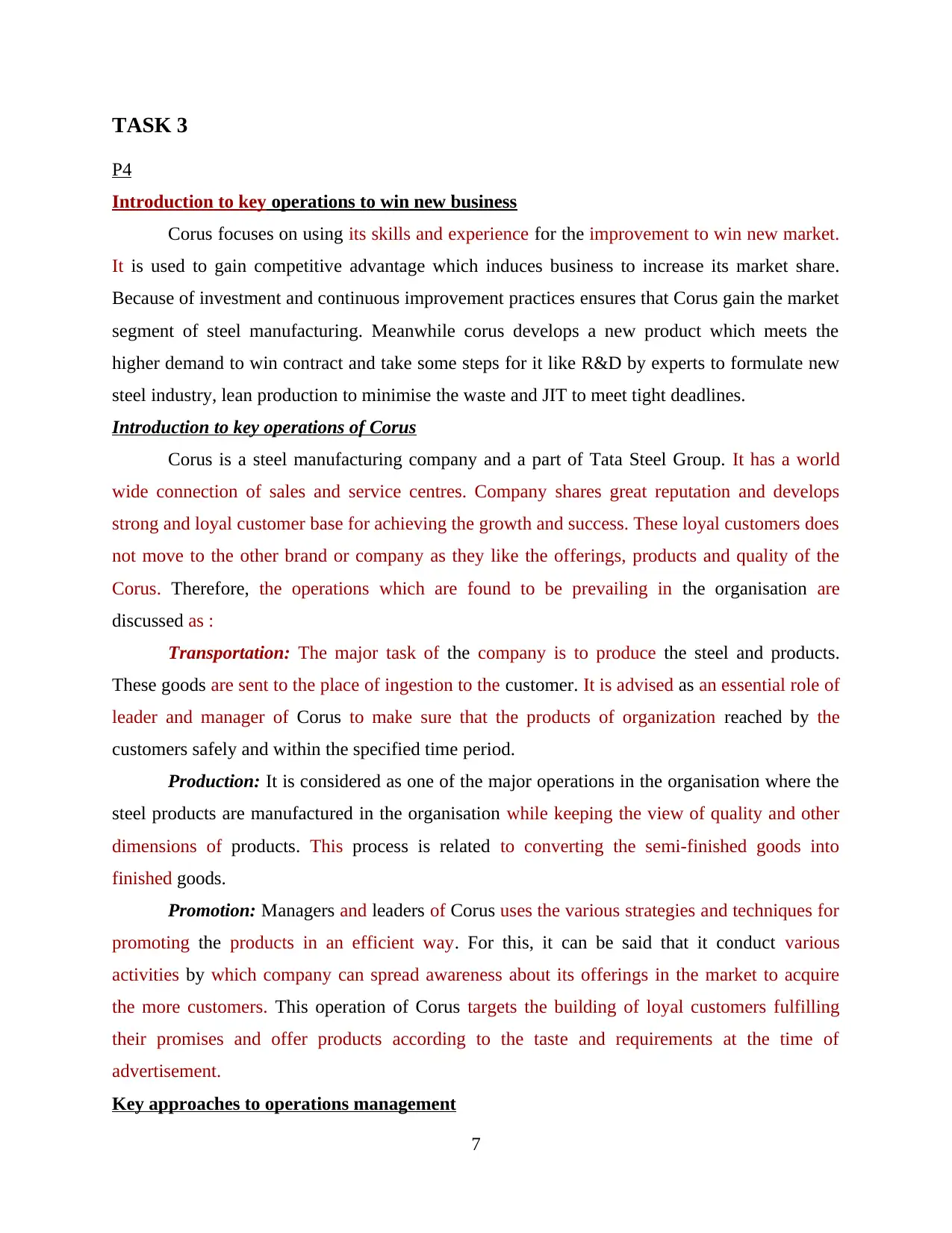
TASK 3
P4
Introduction to key operations to win new business
Corus focuses on using its skills and experience for the improvement to win new market.
It is used to gain competitive advantage which induces business to increase its market share.
Because of investment and continuous improvement practices ensures that Corus gain the market
segment of steel manufacturing. Meanwhile corus develops a new product which meets the
higher demand to win contract and take some steps for it like R&D by experts to formulate new
steel industry, lean production to minimise the waste and JIT to meet tight deadlines.
Introduction to key operations of Corus
Corus is a steel manufacturing company and a part of Tata Steel Group. It has a world
wide connection of sales and service centres. Company shares great reputation and develops
strong and loyal customer base for achieving the growth and success. These loyal customers does
not move to the other brand or company as they like the offerings, products and quality of the
Corus. Therefore, the operations which are found to be prevailing in the organisation are
discussed as :
Transportation: The major task of the company is to produce the steel and products.
These goods are sent to the place of ingestion to the customer. It is advised as an essential role of
leader and manager of Corus to make sure that the products of organization reached by the
customers safely and within the specified time period.
Production: It is considered as one of the major operations in the organisation where the
steel products are manufactured in the organisation while keeping the view of quality and other
dimensions of products. This process is related to converting the semi-finished goods into
finished goods.
Promotion: Managers and leaders of Corus uses the various strategies and techniques for
promoting the products in an efficient way. For this, it can be said that it conduct various
activities by which company can spread awareness about its offerings in the market to acquire
the more customers. This operation of Corus targets the building of loyal customers fulfilling
their promises and offer products according to the taste and requirements at the time of
advertisement.
Key approaches to operations management
7
P4
Introduction to key operations to win new business
Corus focuses on using its skills and experience for the improvement to win new market.
It is used to gain competitive advantage which induces business to increase its market share.
Because of investment and continuous improvement practices ensures that Corus gain the market
segment of steel manufacturing. Meanwhile corus develops a new product which meets the
higher demand to win contract and take some steps for it like R&D by experts to formulate new
steel industry, lean production to minimise the waste and JIT to meet tight deadlines.
Introduction to key operations of Corus
Corus is a steel manufacturing company and a part of Tata Steel Group. It has a world
wide connection of sales and service centres. Company shares great reputation and develops
strong and loyal customer base for achieving the growth and success. These loyal customers does
not move to the other brand or company as they like the offerings, products and quality of the
Corus. Therefore, the operations which are found to be prevailing in the organisation are
discussed as :
Transportation: The major task of the company is to produce the steel and products.
These goods are sent to the place of ingestion to the customer. It is advised as an essential role of
leader and manager of Corus to make sure that the products of organization reached by the
customers safely and within the specified time period.
Production: It is considered as one of the major operations in the organisation where the
steel products are manufactured in the organisation while keeping the view of quality and other
dimensions of products. This process is related to converting the semi-finished goods into
finished goods.
Promotion: Managers and leaders of Corus uses the various strategies and techniques for
promoting the products in an efficient way. For this, it can be said that it conduct various
activities by which company can spread awareness about its offerings in the market to acquire
the more customers. This operation of Corus targets the building of loyal customers fulfilling
their promises and offer products according to the taste and requirements at the time of
advertisement.
Key approaches to operations management
7
⊘ This is a preview!⊘
Do you want full access?
Subscribe today to unlock all pages.

Trusted by 1+ million students worldwide
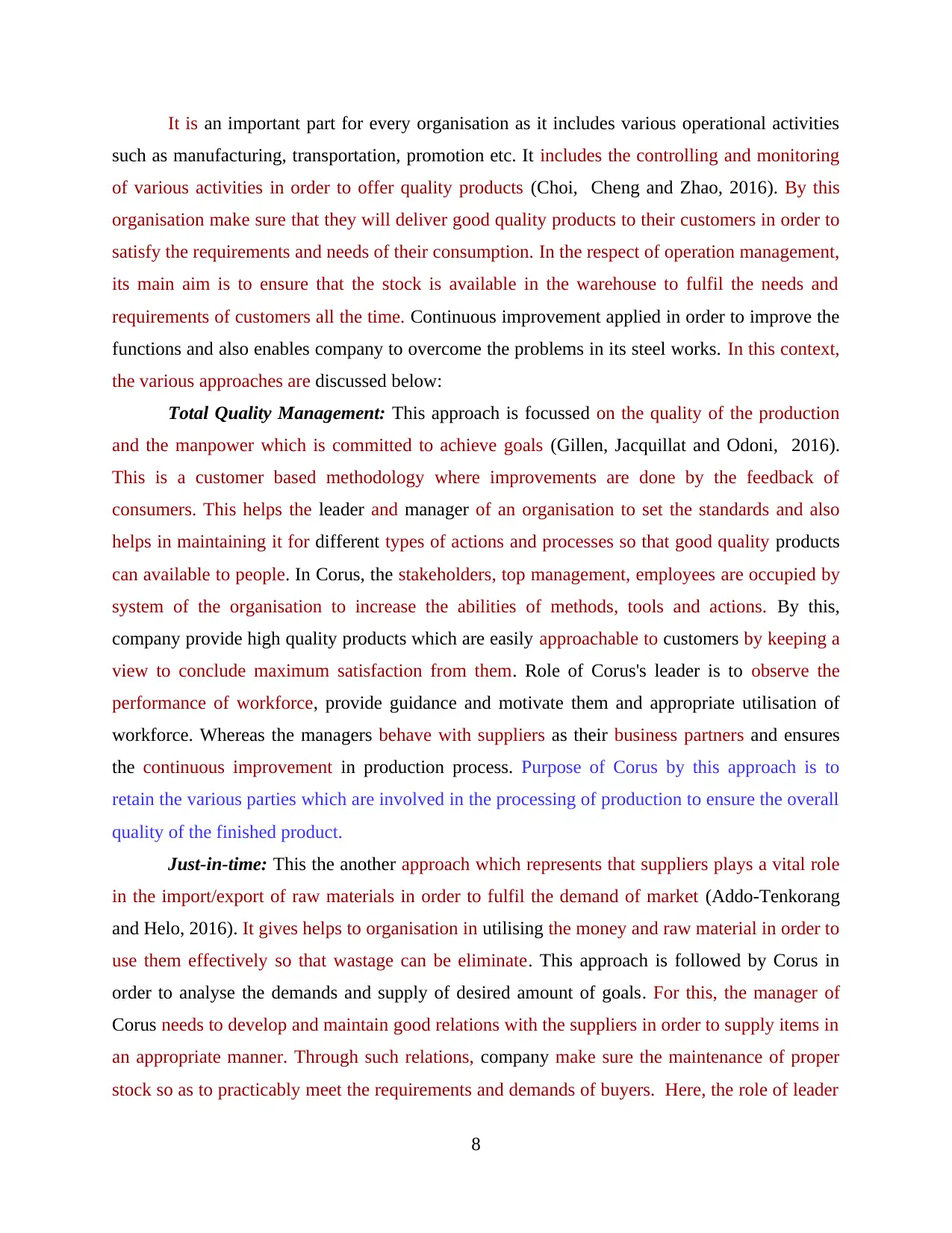
It is an important part for every organisation as it includes various operational activities
such as manufacturing, transportation, promotion etc. It includes the controlling and monitoring
of various activities in order to offer quality products (Choi, Cheng and Zhao, 2016). By this
organisation make sure that they will deliver good quality products to their customers in order to
satisfy the requirements and needs of their consumption. In the respect of operation management,
its main aim is to ensure that the stock is available in the warehouse to fulfil the needs and
requirements of customers all the time. Continuous improvement applied in order to improve the
functions and also enables company to overcome the problems in its steel works. In this context,
the various approaches are discussed below:
Total Quality Management: This approach is focussed on the quality of the production
and the manpower which is committed to achieve goals (Gillen, Jacquillat and Odoni, 2016).
This is a customer based methodology where improvements are done by the feedback of
consumers. This helps the leader and manager of an organisation to set the standards and also
helps in maintaining it for different types of actions and processes so that good quality products
can available to people. In Corus, the stakeholders, top management, employees are occupied by
system of the organisation to increase the abilities of methods, tools and actions. By this,
company provide high quality products which are easily approachable to customers by keeping a
view to conclude maximum satisfaction from them. Role of Corus's leader is to observe the
performance of workforce, provide guidance and motivate them and appropriate utilisation of
workforce. Whereas the managers behave with suppliers as their business partners and ensures
the continuous improvement in production process. Purpose of Corus by this approach is to
retain the various parties which are involved in the processing of production to ensure the overall
quality of the finished product.
Just-in-time: This the another approach which represents that suppliers plays a vital role
in the import/export of raw materials in order to fulfil the demand of market (Addo-Tenkorang
and Helo, 2016). It gives helps to organisation in utilising the money and raw material in order to
use them effectively so that wastage can be eliminate. This approach is followed by Corus in
order to analyse the demands and supply of desired amount of goals. For this, the manager of
Corus needs to develop and maintain good relations with the suppliers in order to supply items in
an appropriate manner. Through such relations, company make sure the maintenance of proper
stock so as to practicably meet the requirements and demands of buyers. Here, the role of leader
8
such as manufacturing, transportation, promotion etc. It includes the controlling and monitoring
of various activities in order to offer quality products (Choi, Cheng and Zhao, 2016). By this
organisation make sure that they will deliver good quality products to their customers in order to
satisfy the requirements and needs of their consumption. In the respect of operation management,
its main aim is to ensure that the stock is available in the warehouse to fulfil the needs and
requirements of customers all the time. Continuous improvement applied in order to improve the
functions and also enables company to overcome the problems in its steel works. In this context,
the various approaches are discussed below:
Total Quality Management: This approach is focussed on the quality of the production
and the manpower which is committed to achieve goals (Gillen, Jacquillat and Odoni, 2016).
This is a customer based methodology where improvements are done by the feedback of
consumers. This helps the leader and manager of an organisation to set the standards and also
helps in maintaining it for different types of actions and processes so that good quality products
can available to people. In Corus, the stakeholders, top management, employees are occupied by
system of the organisation to increase the abilities of methods, tools and actions. By this,
company provide high quality products which are easily approachable to customers by keeping a
view to conclude maximum satisfaction from them. Role of Corus's leader is to observe the
performance of workforce, provide guidance and motivate them and appropriate utilisation of
workforce. Whereas the managers behave with suppliers as their business partners and ensures
the continuous improvement in production process. Purpose of Corus by this approach is to
retain the various parties which are involved in the processing of production to ensure the overall
quality of the finished product.
Just-in-time: This the another approach which represents that suppliers plays a vital role
in the import/export of raw materials in order to fulfil the demand of market (Addo-Tenkorang
and Helo, 2016). It gives helps to organisation in utilising the money and raw material in order to
use them effectively so that wastage can be eliminate. This approach is followed by Corus in
order to analyse the demands and supply of desired amount of goals. For this, the manager of
Corus needs to develop and maintain good relations with the suppliers in order to supply items in
an appropriate manner. Through such relations, company make sure the maintenance of proper
stock so as to practicably meet the requirements and demands of buyers. Here, the role of leader
8
Paraphrase This Document
Need a fresh take? Get an instant paraphrase of this document with our AI Paraphraser
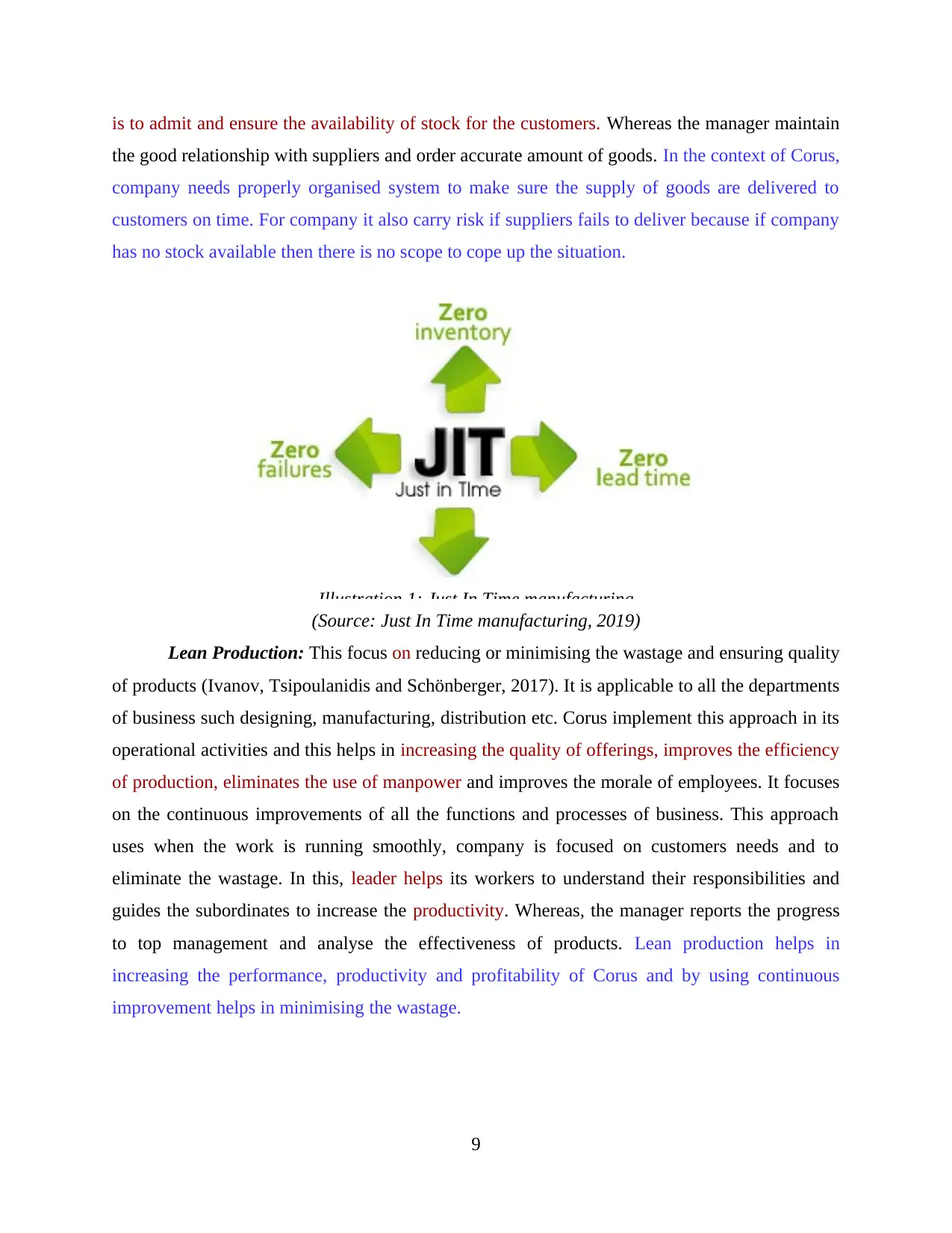
is to admit and ensure the availability of stock for the customers. Whereas the manager maintain
the good relationship with suppliers and order accurate amount of goods. In the context of Corus,
company needs properly organised system to make sure the supply of goods are delivered to
customers on time. For company it also carry risk if suppliers fails to deliver because if company
has no stock available then there is no scope to cope up the situation.
(Source: Just In Time manufacturing, 2019)
Lean Production: This focus on reducing or minimising the wastage and ensuring quality
of products (Ivanov, Tsipoulanidis and Schönberger, 2017). It is applicable to all the departments
of business such designing, manufacturing, distribution etc. Corus implement this approach in its
operational activities and this helps in increasing the quality of offerings, improves the efficiency
of production, eliminates the use of manpower and improves the morale of employees. It focuses
on the continuous improvements of all the functions and processes of business. This approach
uses when the work is running smoothly, company is focused on customers needs and to
eliminate the wastage. In this, leader helps its workers to understand their responsibilities and
guides the subordinates to increase the productivity. Whereas, the manager reports the progress
to top management and analyse the effectiveness of products. Lean production helps in
increasing the performance, productivity and profitability of Corus and by using continuous
improvement helps in minimising the wastage.
9
Illustration 1: Just In Time manufacturing
the good relationship with suppliers and order accurate amount of goods. In the context of Corus,
company needs properly organised system to make sure the supply of goods are delivered to
customers on time. For company it also carry risk if suppliers fails to deliver because if company
has no stock available then there is no scope to cope up the situation.
(Source: Just In Time manufacturing, 2019)
Lean Production: This focus on reducing or minimising the wastage and ensuring quality
of products (Ivanov, Tsipoulanidis and Schönberger, 2017). It is applicable to all the departments
of business such designing, manufacturing, distribution etc. Corus implement this approach in its
operational activities and this helps in increasing the quality of offerings, improves the efficiency
of production, eliminates the use of manpower and improves the morale of employees. It focuses
on the continuous improvements of all the functions and processes of business. This approach
uses when the work is running smoothly, company is focused on customers needs and to
eliminate the wastage. In this, leader helps its workers to understand their responsibilities and
guides the subordinates to increase the productivity. Whereas, the manager reports the progress
to top management and analyse the effectiveness of products. Lean production helps in
increasing the performance, productivity and profitability of Corus and by using continuous
improvement helps in minimising the wastage.
9
Illustration 1: Just In Time manufacturing
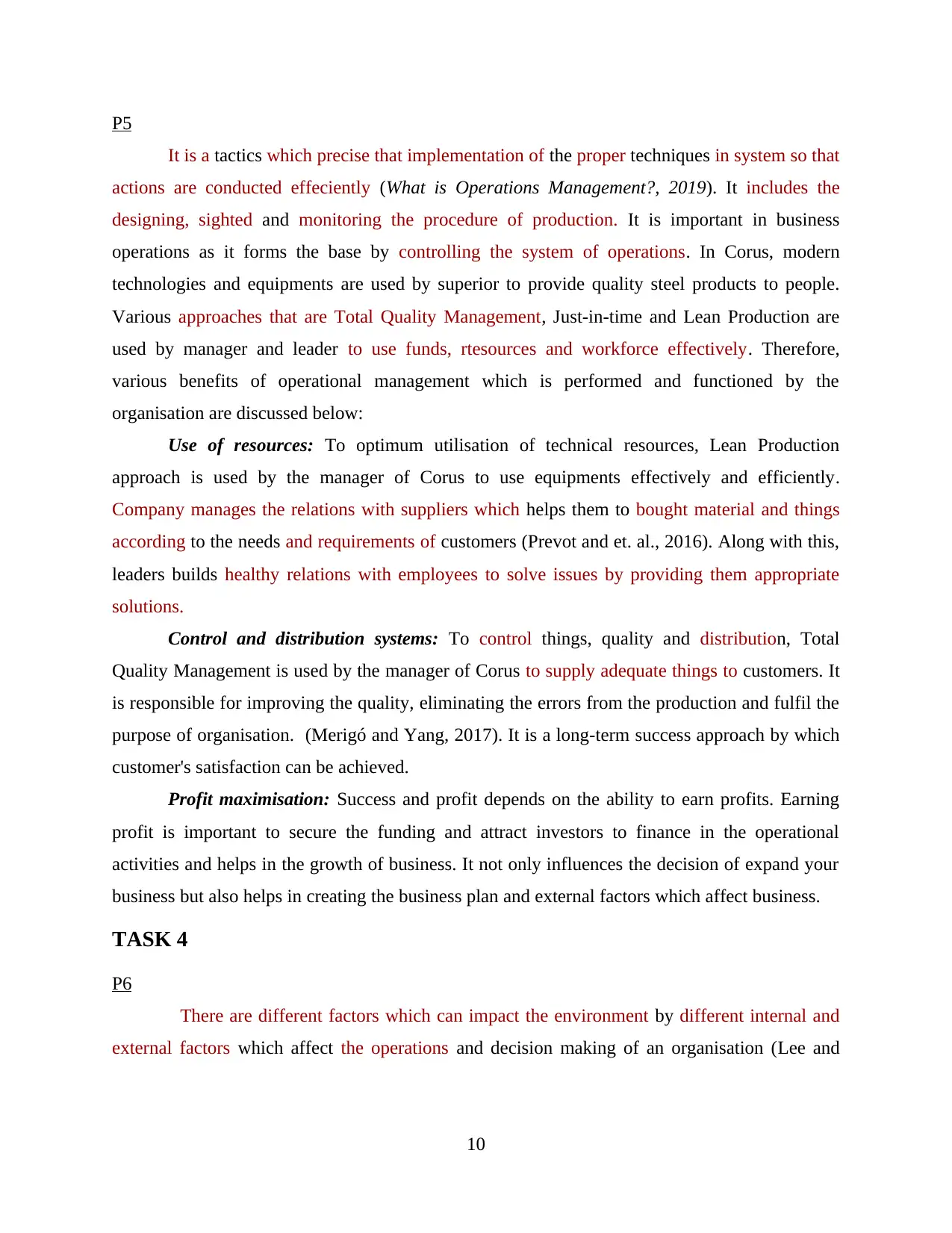
P5
It is a tactics which precise that implementation of the proper techniques in system so that
actions are conducted effeciently (What is Operations Management?, 2019). It includes the
designing, sighted and monitoring the procedure of production. It is important in business
operations as it forms the base by controlling the system of operations. In Corus, modern
technologies and equipments are used by superior to provide quality steel products to people.
Various approaches that are Total Quality Management, Just-in-time and Lean Production are
used by manager and leader to use funds, rtesources and workforce effectively. Therefore,
various benefits of operational management which is performed and functioned by the
organisation are discussed below:
Use of resources: To optimum utilisation of technical resources, Lean Production
approach is used by the manager of Corus to use equipments effectively and efficiently.
Company manages the relations with suppliers which helps them to bought material and things
according to the needs and requirements of customers (Prevot and et. al., 2016). Along with this,
leaders builds healthy relations with employees to solve issues by providing them appropriate
solutions.
Control and distribution systems: To control things, quality and distribution, Total
Quality Management is used by the manager of Corus to supply adequate things to customers. It
is responsible for improving the quality, eliminating the errors from the production and fulfil the
purpose of organisation. (Merigó and Yang, 2017). It is a long-term success approach by which
customer's satisfaction can be achieved.
Profit maximisation: Success and profit depends on the ability to earn profits. Earning
profit is important to secure the funding and attract investors to finance in the operational
activities and helps in the growth of business. It not only influences the decision of expand your
business but also helps in creating the business plan and external factors which affect business.
TASK 4
P6
There are different factors which can impact the environment by different internal and
external factors which affect the operations and decision making of an organisation (Lee and
10
It is a tactics which precise that implementation of the proper techniques in system so that
actions are conducted effeciently (What is Operations Management?, 2019). It includes the
designing, sighted and monitoring the procedure of production. It is important in business
operations as it forms the base by controlling the system of operations. In Corus, modern
technologies and equipments are used by superior to provide quality steel products to people.
Various approaches that are Total Quality Management, Just-in-time and Lean Production are
used by manager and leader to use funds, rtesources and workforce effectively. Therefore,
various benefits of operational management which is performed and functioned by the
organisation are discussed below:
Use of resources: To optimum utilisation of technical resources, Lean Production
approach is used by the manager of Corus to use equipments effectively and efficiently.
Company manages the relations with suppliers which helps them to bought material and things
according to the needs and requirements of customers (Prevot and et. al., 2016). Along with this,
leaders builds healthy relations with employees to solve issues by providing them appropriate
solutions.
Control and distribution systems: To control things, quality and distribution, Total
Quality Management is used by the manager of Corus to supply adequate things to customers. It
is responsible for improving the quality, eliminating the errors from the production and fulfil the
purpose of organisation. (Merigó and Yang, 2017). It is a long-term success approach by which
customer's satisfaction can be achieved.
Profit maximisation: Success and profit depends on the ability to earn profits. Earning
profit is important to secure the funding and attract investors to finance in the operational
activities and helps in the growth of business. It not only influences the decision of expand your
business but also helps in creating the business plan and external factors which affect business.
TASK 4
P6
There are different factors which can impact the environment by different internal and
external factors which affect the operations and decision making of an organisation (Lee and
10
⊘ This is a preview!⊘
Do you want full access?
Subscribe today to unlock all pages.

Trusted by 1+ million students worldwide
1 out of 15
Related Documents
Your All-in-One AI-Powered Toolkit for Academic Success.
+13062052269
info@desklib.com
Available 24*7 on WhatsApp / Email
![[object Object]](/_next/static/media/star-bottom.7253800d.svg)
Unlock your academic potential
Copyright © 2020–2025 A2Z Services. All Rights Reserved. Developed and managed by ZUCOL.





